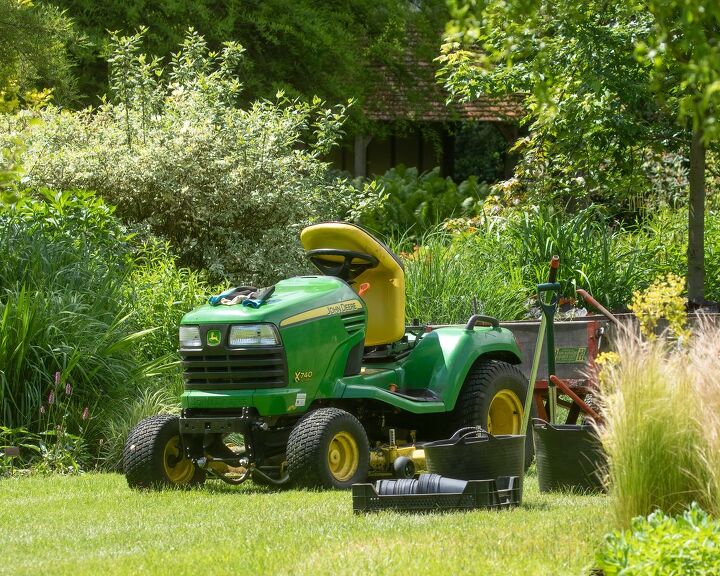How To Bypass The Safety Switch On A John Deere Lawnmower

Your modern John Deere lawnmower has three safety switches that safeguard against a variety of situations. One protects breaking, another manages cutting blades or other accessories, and the final switch guards against operation without an operator. The latter of which is referred to as the seat safety switch, and kills the engine or keeps it from starting unless the rider is sitting in the seat.
For one reason or another, you may need to bypass the safety switches on your John Deere lawnmower. If this is the case, you’ve come to the right place. We’ll show you all the necessary steps for disabling some of the safety features on your riding tractor.
How to Bypass the Seat Safety Switch on John Deere Lawnmower
Thousands of people are injured each year in riding mower accidents. The most prevalent ones being loss of control of the tractor or coming into contact with the blades. Because of this, manufacturers provide the seat safety switch that helps to determine if an operator is still in control of the lawnmower.
By monitoring pressure, the switch knows to shut off power to the blades when the seat becomes unoccupied. The switch itself looks like a four-pronged plug with a push-button on top. Inside of the switch, there are two sets of contacts at the base of the button. One completes the circuit between two of the blades, while the other completes the circuit between the second pair.
When the operator sits in the seat and presses down on the button, the connection is completed between the battery and the engine. However, when the pressure is no longer present, it breaks and grounds itself, resulting in the engine stopping. Located directly under the seat, this safety switch can be disabled when needed. Though, it should be notated that by bypassing this feature, you do create the conditions for both bodily and property harm. If the seat safety switch is permanently disabled, you also risk voiding the manufacturer’s warranty.
- Shut off the engine of your lawnmower and take the key out of the ignition.
- Lift the seat of your mower and, if it was recently running, allow the engine to cool down first. To remove the seat, you’ll only need to detach one bolt that keeps the seat from sliding forward.
- Locate the seat safety switch on the bottom of the seat. It will appear like a plastic wire harness and be attached to the underside of the seat. You should see two wires running from the engine to the switch.
- Cut each wire using wire cutters and gather the wires into your hand. DO NOT allow the wires to drop down into the mower. Hold onto them tightly.
- Using wire strippers, strip off the ends of each wire. Then, take the ends of the wires and twist them together.
- Cover the two entwined wires with a wire nut and twist to secure. Then, hold the wire nut in place by wrapping both the wires and the nut itself in electrical tape.
- Replace the seat on your John Deere riding mower, and continue normal operation.
Again, while these steps do allow you to bypass the seat safety switch on your John Deere lawnmower, you put yourself and your property at risk. Consider this fact before you disable the safety switch.
A Faulty Seat Safety Switch on John Deere Lawnmower
One of the primary reasons for needing to bypass the seat safety switch on a John Deere lawnmower is because the switch itself is malfunctioning. In this case, whether the operator is in the seat or not, the mower will not turn over. These safety switches are incredibly simple mechanisms, and the small wires at the base of the button can break, bend, or corrode.
When the seat safety switch is broken or defective, it cannot complete the circuit that is needed to allow the engine to operate. While the circuit can be “jumped” by disabling the switch entirely, manufacturers caution against this. Instead, replace the switch, as it is both inexpensive and easy to install yourself.
How to Bypass the Reverse Safety Switch on John Deere Lawnmower
Another safety device that is factory-equipped on most lawnmowers manufactured by John Deer is the reverse safety switch. This switch is typically located under the hood of your lawnmower, near the negative post of the battery. Its purpose is to prevent the operator from switching into reverse while the cutting blades are spinning or the deck is down. In order for the gear to work, the rider must first disable the cutting deck then they can shift into reverse.
The purpose of the reverse safety switch is to safeguard against accidental bodily harm or property damage, as the operator may not have full sight of the obstacles behind him/her. Using just a few tools, the reverse safety switch on your John Deere lawn mower can be bypassed.
- Turn off your John Deere lawnmower, remove the key from the engine, and allow it to cool down before proceeding.
- Lift the hood of your mower and locate the battery.
- Using a ratchet and appropriately sized socket, disconnect the battery beginning with the negative post. Then, detach the positive cable from the terminal.
- Locate the reverse safety switch next to the negative post of the battery. Search for a plastic harness with wires.
- Grip both the plastic harness and the wires, press down on the side tabs, and pull to unplug the wires from the harness by hand. If you are unable to release the wires by hand, disconnect them using a pair of pliers.
- Use a ratchet and appropriately sized socket to reattach each battery wire to the correct post. Begin with the positive, or red, cable.
- Lower the hood on your mower, and the reverse safety switch has not been bypassed.
- Sit in the seat, insert the key in the ignition, engage the cutting blades and place the tractor in reverse to test its functionality.
By bypassing the reverse safety switch, you may create the circumstances for both property and bodily harm. Also, as with the seat safety switch, when you permanently deactivate the reverse safety switch, you may render the manufacturer’s warranty invalid.
Related Questions
How do you bypass the key switch on a John Deere lawnmower?
Most riding mowers come equipped with starter keys. While this is mostly due to safety, it also protects against theft. However, there may come a time where you have a lost or broken key switch and need to get it started with an alternative method.In this case, you can start it with jumper cables or by hot wiring with a screwdriver. To use jumper cables, wear rubber gloves, and make sure the blade is disengaged. Then, locate the battery under the hood, and clamp the black booster cable around the mower’s negative post and the other end to the mower’s metal deck. Attach the red cable to the positive side and the other end to the metal piece on the mower’s starter.Once the engine turns over, remove the red cable first and then follow up with the black booster cable. Alternatively, if the two electrical posts you need to engage are close together, you can use a screwdriver to touch both of the posts. This should cause the engine to start and allow you to effectively bypass the key switch.
Why is my John Deere lawnmower starting and then quickly dying?
If your John Deere lawn mower starts up but then shuts down after a few seconds, this could be the result of a number of issues. In most cases, the problem is attributed to the fuel cap, the spark plug, the fuel, or the carburetor. The first thing you should try is removing the carburetor and giving it a good clean. If old fuel was left in the engine for too long, it can cause the carburetor to become gunked up and stop functioning correctly.If the issue lies with the fuel cap, this means that one of the small vents that allow air into the gas tank is blocked. In this case, you’ll need to replace your fuel cap. The final thing to check is your spark plug or ignition coil. If either of them has become damaged or is loose, the connection will not be enough to keep the engine running.
Related Guides

Jessica considers herself a home improvement and design enthusiast. She grew up surrounded by constant home improvement projects and owes most of what she knows to helping her dad renovate her childhood home. Being a Los Angeles resident, Jessica spends a lot of her time looking for her next DIY project and sharing her love for home design.
More by Jessica Stone



















![Cost To Drill A Well [Pricing Per Foot & Cost By State]](https://cdn-fastly.upgradedhome.com/media/2023/07/31/9074980/cost-to-drill-a-well-pricing-per-foot-cost-by-state.jpg?size=350x220)





![How To Reset A Whirlpool Cabrio Washer [In 5 Easy Steps!]](https://cdn-fastly.upgradedhome.com/media/2023/07/31/9076531/how-to-reset-a-whirlpool-cabrio-washer-in-5-easy-steps.jpg?size=350x220)

